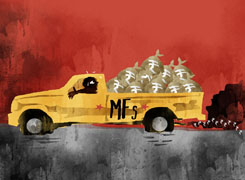Should I surrender my ABSL Weathsmart fund after just 1 month?
Ramalingam Kalirajan |10219 Answers |Ask -Follow
Mutual Funds, Financial Planning Expert - Answered on Aug 22, 2024
He has an MBA in finance from the University of Madras and is a certified financial planner.
He is the director and chief financial planner at Holistic Investment, a Chennai-based firm that offers financial planning and wealth management advice.... more

Hi Sir I just purchase ABSL weath smart fund with 3.5 amnul primium. after that I reallise that made mistake n purchased without proper reaserch. juat 1 month primium paid... should in surrnader this plan?
Understanding the ABSL Wealth Smart Fund
Before deciding to surrender the policy, it's crucial to understand what you’ve purchased. The ABSL Wealth Smart Fund is likely an insurance-cum-investment plan. These plans often combine life insurance with an investment component, typically in mutual funds or market-linked instruments. While they offer some benefits, there are also downsides to consider.
Advantages:
Insurance Cover: Provides life insurance along with investment opportunities.
Regular Premium Payments: Encourages disciplined saving.
Potential for Growth: Market-linked returns, which could be higher than traditional savings plans.
Disadvantages:
High Costs: These plans usually come with higher charges, such as fund management fees and mortality charges.
Lower Returns: Due to the costs, the net returns might be lower than what you'd get from pure investment products.
Complexity: These plans are complex, making it hard to understand the returns, costs, and benefits.
Lock-In Period: Typically, there’s a lock-in period of 5 years, during which surrendering might lead to financial losses.
Assessing the Surrender Option
Since you’ve only paid one premium, surrendering the policy is an option. But, let’s carefully evaluate the pros and cons of doing so.
Pros of Surrendering:
Limited Financial Loss: Surrendering early might limit your financial loss. You may lose a portion of your premium, but it might be better than continuing with a plan that doesn't meet your needs.
Opportunity for Better Investment: The funds can be redirected into more suitable investment options with potentially higher returns.
Simplified Financial Portfolio: By focusing on separate insurance and investment products, you can gain better clarity and control over your finances.
Cons of Surrendering:
Initial Financial Loss: Early surrender usually means a loss on the premium already paid.
Missed Potential Benefits: If the market performs well, there might be missed growth opportunities.
Administrative Hassles: The surrender process might involve paperwork and time.
Alternative Investment and Insurance Strategies
If you decide to surrender, consider reallocating your funds into more effective and straightforward financial products. Here's how you can approach it:
Separate Insurance and Investment
Term Insurance: A pure term insurance plan can offer high life cover at low costs. It's straightforward and serves the primary purpose of insurance—financial protection.
Mutual Funds: Instead of a combined insurance-investment plan, you might consider investing in mutual funds for wealth creation. Mutual funds are flexible, transparent, and can be chosen based on your risk tolerance and investment horizon.
Evaluate Existing Investments
Assess Existing Mutual Funds: Review your current mutual fund portfolio. Ensure it aligns with your risk profile and long-term goals.
Diversification: Make sure your investments are diversified across asset classes and sectors to minimize risk.
Regular Monitoring: Keep track of your investments periodically. It's important to rebalance the portfolio if it strays from your financial objectives.
Consultation with a Certified Financial Planner
Considering the complexity of your situation, it might be beneficial to consult with a Certified Financial Planner (CFP). A CFP can help you:
Conduct a Thorough Review: They can assess your current financial position, including the ABSL Wealth Smart Fund and other investments.
Create a Customized Plan: They’ll help you create a plan that aligns with your financial goals, whether it's wealth creation, retirement planning, or securing your family’s future.
Ongoing Advice: A CFP can provide continuous advice as your financial situation evolves.
Final Insights
Surrendering the ABSL Wealth Smart Fund after just one premium might seem like a loss. However, this decision could help you avoid larger financial losses in the future if the plan doesn’t align with your goals. By separating your insurance and investment needs, you can achieve a more focused and efficient financial strategy.
Investing with clarity and purpose is crucial. A well-thought-out financial plan will provide you with peace of mind and a secure financial future.
If you’re unsure, consulting with a Certified Financial Planner will offer the guidance and assurance needed to make informed decisions.
Best Regards,
K. Ramalingam, MBA, CFP,
Chief Financial Planner,
www.holisticinvestment.in
You may like to see similar questions and answers below
Ramalingam Kalirajan |10219 Answers |Ask -Follow
Mutual Funds, Financial Planning Expert - Answered on May 14, 2024
Ramalingam Kalirajan |10219 Answers |Ask -Follow
Mutual Funds, Financial Planning Expert - Answered on May 21, 2024
Ramalingam Kalirajan |10219 Answers |Ask -Follow
Mutual Funds, Financial Planning Expert - Answered on Jul 27, 2024
Ramalingam Kalirajan |10219 Answers |Ask -Follow
Mutual Funds, Financial Planning Expert - Answered on Jul 16, 2024
Ramalingam Kalirajan |10219 Answers |Ask -Follow
Mutual Funds, Financial Planning Expert - Answered on Jun 21, 2025
Nayagam P P |10170 Answers |Ask -Follow
Career Counsellor - Answered on Aug 11, 2025
Nayagam P P |10170 Answers |Ask -Follow
Career Counsellor - Answered on Aug 11, 2025
Dr Nagarajan J S K |2257 Answers |Ask -Follow
NEET, Medical, Pharmacy Careers - Answered on Aug 11, 2025
T S Khurana |502 Answers |Ask -Follow
Tax Expert - Answered on Aug 11, 2025
T S Khurana |502 Answers |Ask -Follow
Tax Expert - Answered on Aug 11, 2025
Nayagam P P |10170 Answers |Ask -Follow
Career Counsellor - Answered on Aug 11, 2025
Radheshyam Zanwar |6277 Answers |Ask -Follow
MHT-CET, IIT-JEE, NEET-UG Expert - Answered on Aug 11, 2025
Nayagam P P |10170 Answers |Ask -Follow
Career Counsellor - Answered on Aug 11, 2025
Nayagam P P |10170 Answers |Ask -Follow
Career Counsellor - Answered on Aug 11, 2025
Nayagam P P |10170 Answers |Ask -Follow
Career Counsellor - Answered on Aug 11, 2025






















